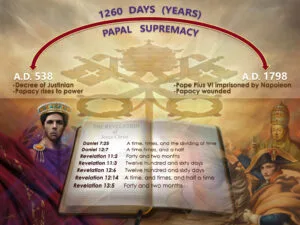How to Interpret Prophecy Aright – Or Not
 Protestant reformers like Martin Luther used a system of prophetic interpretation based on fulfilled prophecies of the past. They found the keys to prophecies for the future in fulfilled prophecies of the past. They saw, for instance, how prophecies had been given in days and fulfilled in years. They saw names and animals that had been used for certain world powers, and they saw these same names and some of the same animals used in prophecies for the future. When Martin Luther used this system to interpret the prophecies of Revelation, he concluded that the system of the papacy was the antichrist in the book of Revelation.
Protestant reformers like Martin Luther used a system of prophetic interpretation based on fulfilled prophecies of the past. They found the keys to prophecies for the future in fulfilled prophecies of the past. They saw, for instance, how prophecies had been given in days and fulfilled in years. They saw names and animals that had been used for certain world powers, and they saw these same names and some of the same animals used in prophecies for the future. When Martin Luther used this system to interpret the prophecies of Revelation, he concluded that the system of the papacy was the antichrist in the book of Revelation.
Now keep in mind that it was never Martin Luther’s intention to start a new church. He wanted to reform the Catholic church. He was trying to work within the church to bring it back to the Bible, but when the church refused to go back to the Bible, Luther had to move forward.
John Hus, John Knox and many more Protestant reformers preached that the Pope was the antichrist, and that interpretation was carried on by the churches they founded. The 1260 day-for-a-year prophecy has demonstrated their calculations to be correct. Yet today, while we understand that God has His people in every church, including the Catholic church, 1many are afraid to identify the antichrist in Revelation as the papal system. Because of this, a new way of studying Bible prophecy was devised, 2which is what we now know as the futuristic approach in place of the previous historicist approach used by the Reformers and earlier Christians. It played an important role in the Counter Reformation. This places all of the events in Revelation in the future so as not to identify the papacy as the antichrist. However, this theory has several flaws.
For instance, in January 1991, the United States began Desert Storm to relieve Kuwait from Iraqi oppression. U.S. helicopters and other aircraft were swarming the desert. At the time, a popular theologian in the futuristic tradition suggested that Revelation 9:3 was being fulfilled since the locusts mentioned in this passage were symbolic of the helicopters swarming the desert.
The problem with that interpretation is that Revelation 9 has already been precisely fulfilled, using the day-for-a-year principle concerning 391 years and 15 days, ending on exactly August 11, 1840, when the Ottoman Empire accepted guarantees and declared its dependence upon surrounding nations to survive. 3When this prophecy was fulfilled right down to the exact day of August 11, 1840, many people who had scoffed at the Bible became Bible-believing Christians.
Today most popular Protestant churches have rejected the historicist method of interpreting prophecy, as it is no longer politically correct to identify the antichrist biblically. They have joined the Catholic church’s interpretation of prophecy in Revelation to put everything in the future, thus nullifying much of what was accomplished and gained in the Reformation.
Here are some problems that exist now with the futuristic view of prophecy.
With the futuristic approach to Revelation, there is no way to determine the probable accuracy of an interpretation because there are no checks and balances, such as the day-for-a-year principle, to test predictions. For example, Desert Storm does not fit the time period for Revelation 9. However, interpretations using the day-for-a-year principle fall into place with other prophecies in Daniel and Revelation. With the futuristic approach, there is no rhyme or reason to interpretations, and many predictions are only proven wrong once they don’t come to pass. That’s why some have called The Revelation “the happy hunting ground of fraudsters and religious fanatics.”
The futuristic view denies all prophecies that have already been accurately fulfilled using the day-year principle by putting them in the future. This means nullifying much of the evidence that the Bible is true. This destroys not only the credibility of prophecies but of the Bible itself.
While recognizing that God has His people in all churches, and that every church has sincere worshipers who will make up the kingdom of heaven, we should not be afraid to teach accurate prophetic interpretations, even though they may not be currently “politically correct.”
By using the historical day-for-year principle in studying the prophecies of Revelation, we prove the Bible to be true and trusted by what has already been accurately fullfifilled, and we can properly warn all of God’s people in all of us churches of the false teachers and their doctrines which lead men away from Jesus, as our only True Teacher.
Do you have any experience to share about the day-for-a-year principle compared to the futuristic view?
References
- I believe there will be more Catholics in heaven than in any other church. ↩
- Look up Francisco Ribera (1537–1591), the originator of the futuristic approach to prophecy. ↩
- You can see a facsimile copy of Josiah Litch’s original article in the Signs of the Times of Aug. 1, 1840 ↩
 (17)
(17)